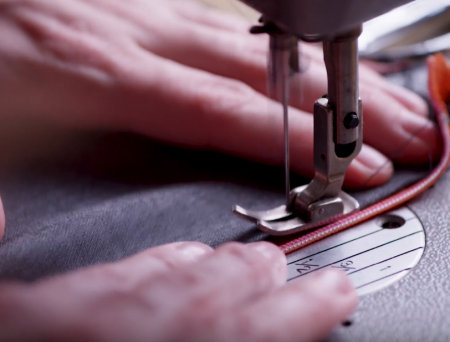The fields of medical device and apparel design may not seem to have a lot in common, but alumni from the College of Design are changing that.

Alumna Anna Peshock (B.S. ’15, Apparel Design) and Shannon Williamson (B.S. ’11, Apparel Design; M.S. ’17, Medical Device Innovation), are using their apparel design skills to take on the challenges of designing, developing, and commercializing medical devices by building on their apparel backgrounds with the College of Science and Engineering’s Master of Science in Medical Device Innovation degree.
After working in traditional apparel production, Peshock was inspired by her personal experiences to pursue a graduate degree that blends apparel and healthcare design. “I have several chronic medical conditions and as a consumer of medical products, I realized that there was a tremendous opportunity to improve the patient experience and enhance the design of products to be better suited for the patient’s lifestyle,” said Peshock. Williamson felt a similar call and entered the healthcare field to make a difference in people’s health and lives.
Armed with a strong foundation in design fundamentals and passion to prioritize the user, Peshock and Williamson are weaving their apparel design expertise into their current program. “The steps of the design process are the same regardless of the product. My knowledge of the process, and my understanding of the iterative nature of design, has prepared me to create medical devices with longer life cycles,” said Williamson.
“Being aware of user needs and how people will use the final product is something we practiced from day one in the apparel design program,” explained Peshock. “Regardless of what product you are designing, you must always remember who you are designing for and take time to understand how they will use the product, not how you want them to use it. The way to change the negative connotation surrounding medical devices is to approach their design in the same way we approach apparel design: with consumer experience at the forefront.”
We do not often associate medical devices with emotion, but Peshock’s most important takeaway from the apparel design program is that emotional connection is as important as functionality. “When people have an emotional connection with clothing, it can help them express part of their personality and give them the confidence to take on challenges they might otherwise avoid,” said Peshock. “The greatest advantage I have from the apparel program is being able to bring the voice of the customer to medical products, and creating products that not only enhance the lives of patients but are something they are proud to use.”
“The apparel design program taught me that design is more than dreaming,” reflected Williamson. “The design is your vision, but to get there you must be willing to collaborate, embrace the process, and work hard to achieve the end goal. It’s not just aptitude, it’s attitude and commitment and it’s great fun.”
In her senior year of college, Anna Peshock (B.S. ’15, Apparel Design) took an internship at a small start-up called Shinesty.
When Professor Emeritus Karen LaBat (Apparel Design) met medical doctor Karen Ryan (M.S. ’06, Apparel Studies) in 2002, they found that they shared a passion for improving the design of wearable products so that all people can enjoy safe, fully functional, and innovative products.
A breakthrough invention in wearable technology has the potential to change how we interact with the clothes we wear every day.





